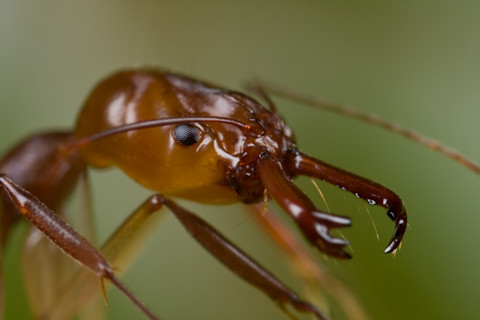
When trap-jaw ants find themselves in trouble, they’ll literally flip out. Trap-jaw ants have specialized, spring-loaded jaws that snap shut at some of the fastest speeds ever recorded for animal movement. They deploy those powerful mandibles primarily to attack and throw enemies, but trap-jaws, scientists recently discovered, also use their chops defensively to fling themselves away from predators by executing a maneuver called the “jaw jump.”
In Enemy Territory
Wherever you find a trap-jaw ant colony, you’re bound to find antlions. Antlion larvae dig pits in sand, bury themselves at the bottom and wait for foraging insects, like a trap-jaw, to wander into their trap. The pit’s sides are unstable, and struggling insects slide toward the bottom, where they are nabbed and pulled under the sand by a hungry antlion.
Sometimes, when trap-jaws fall into antlion pits, they’ll suddenly twitch, get airborne and backflip out of danger. Scientists have observed trap-jaws leaping in the wild for over a century, but it was generally assumed this behavior was purely coincidental, the result of randomly snapping their jaws against a solid object. However, in a study published Wednesday in PLOS One, scientists demonstrated that this behavior is quite intentional and is a prime example of evolutionary co-option, where a trait that evolved for one function is used for another.
Flipping Out
Scientists conducted 117 trials that pitted (no pun intended) an antlion against a trap-jaw in a plastic container filled with sand. Scientists then recorded the trap-jaws’ methods of escape. Antlions won roughly 30 percent of the battles, and in most cases the trap-jaw simply crawled out of the pit. But in 15 percent of the trials, the trap-jaws escaped by snapping their jaws against the pit walls to perform their signature leap.
To test whether the jaw jump increased the odds of survival, scientists glued some of the ants’ jaws together to disable their leaping ability. Sure enough, their odds of escaping dropped significantly. Based on their calculations, scientists say a trap-jaw’s leap provides a twofold increase in its chances of survival during an encounter with an antlion.
Co-Opted
Not all species of trap-jaw ants can perform this life-saving jump; this experiment used a species called Odontomachus brunneus. There are over 160 species of trap-jaw ants, so jaw jumping may represent a key morphological innovation unique to this species. Other trap-jaw species, for example, never attempt to jump when they are trapped in an antlion pit.
However, only a small fraction of trap-jaw species have been studied, so scientists will need more observations to determine if this is a truly divergent skill.
Photo credit: kurt_G/Shutterstock













